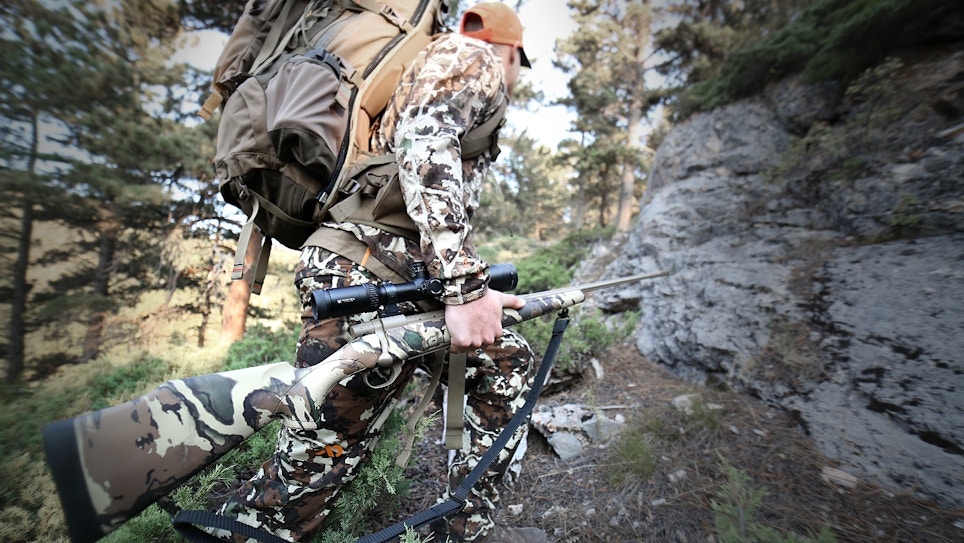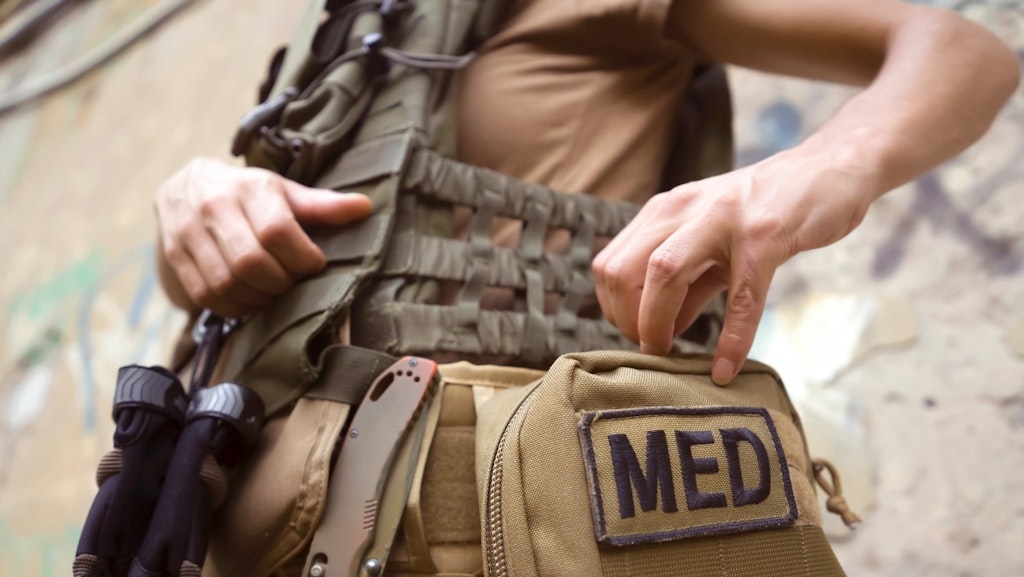On November 13, 2011, Kinney Noe, owner of Curtsinger’s Sunrise Outfitters in Danville, Kentucky, joined his daughter Kandis and his friend David for an exciting day hunting whitetails in the great Kentucky outdoors. His farm had several stand locations to choose from, but today he chose the 30-foot stand, about a mile from Kandis. This stand was affixed to an old radio antenna that towered at 30 feet, providing the perfect view of the woods and fields below. Under the mask of darkness, the hunters quietly navigated to their strategic location and excitement filled the air.
The Tragedy
At 6:15 a.m., now 30 feet above the earth, Kinney decided to stand up and turn to make sure he had clearance for the perfect shot when his trophy appeared — and tragedy struck. For an unknown reason, the stand gave way, and he and his grandfather’s loaded 257 rifle fell to the ground below. Falling feet first, on the way down he struck a tree limb that impaled his body through his right side just above his belt, piercing through his bowels, liver, diaphragm and lung, nearly exiting his back. He lay nearly paralyzed and in excruciating pain on the cold Kentucky ground, able to move only his right hand. Miraculously, he was able to retrieve his phone, which rarely had cellular reception in this area. He was unable to see the phone clearly, but he knew if he hit the “call” button twice, it would call his last contact, Kandis.
Kandis, a mile away, came to his rescue and was able to call her mother, Rita, who activated EMS response and a prayer chain of friends and family. Two EMS agencies joined to respond; however, the farm was remote and had no physical address. David met the EMS crews at a school close by and led them to the scene, where they loaded the stretcher in the back of a pickup truck and drove the crew to Kinney, who still lay motionless in severe pain, clinging to his life.
Air Evac was activated, and within minutes, the Red, White, and Blue Bell 206 helicopter was landing in the nearby field. Stepping out of the helicopter was a family friend of Kinney’s, Aaron Stamper, flight paramedic and now a 5 Stone Pro-Staff member. With the utmost professionalism and compassion, Kinney was swiftly loaded onto the helicopter, and they were airlifted to the University of Kentucky. The vibration of rotors on the helicopter caused the pain to intensify and the agony to continue. Aaron and the flight nurse worked diligently to stabilize Kinney and provide pain relief. Feeling hopeless as Kinney yelled out in pain, the flight nurse knelt on her knees and prayed during the 15-minute flight to UK. God was also at work. While on the way to the emergency department, Kinney asked Aaron, “Do me a favor and tell my wife and daughters I love them very much if I don’t make it through this.”
Treatment and Recovery
Within an hour and a half, Kinney was at UK’s emergency department seeking the highest level of care. Kinney states he was given over 90 units of blood, spent over 3 months in ICU, underwent multiple surgeries, became septic (systemic infection), and had pneumonia and irregular heart rhythms. His heart even stopped several times, and he has to be resuscitated. He went to rehabilitation for a month after his release from the hospital. Today, he suffers “only” from decreased kidney function, nerve damage to his left hand, and numbness in his feet.
Kinney now travels several states giving presentations at hospitals and churches, sharing his testimony of how he was saved by God’s grace and the swift actions of Kandis, Rita and the medical professionals. He states that his near-death experience has given him “a second chance at life.” He has a mission to help others be aware of hunter’s safety, encouraging equipment checks, wearing safety harnesses and supporting local blood drives.
Focus on Preparedness
Hunter and outdoors safety is often approached with the focus on areas like firearm safety and boater safety. While these areas are critical to address, we must also focus on being proactive. Preparedness planning is a systematic process that can help assure that outdoorsmen and women have considered and addressed critical safety hazards. This not only includes providing information and making sure gear is available and functional, but it also means also having obtained professional life saving training.
Let’s look at a few areas that every hunter should consider to help mitigate the risks associated with being outdoor enthusiasts. In each of these categories, you’ll find gear you can stock to help save a life.
Communication
When an emergency strikes, communication is key, and this involves more than just being able to communicate once out in the field with a phone or two-way/HAM radio (although those are important). Lifesaving communication requires a plan informing others on specific activities, locations, dates, check-in times, contact and medical info, route planning, and emergency service activation numbers.
Supplies Checklist
In Kinney Noe’s story we can see how equipment failure of the stand and lack of a safety harness ultimately led to his accident and near-death experience. Kinney would be the first to admit he was blessed that day and mostly unprepared for the tragic accident he suffered. A valuable lesson learned is that experienced hunters can fall victim to accidents just as the inexperienced adventurist can. Supplies such as a tourniquet, medical kit, survival kit, signaling equipment, emergency whistle, and back-up communications are all necessary to help ensure positive outcomes in dire situations. Are you stocking these in your store? Are you actively marketing them to hunters and explaining why they should be prepared to treat puncture wounds, gunshot wounds, deep cuts from knives or broadheads, and more in the woods? Help isn’t always immediately available, and having a few simple items like a tourniquet and packing gauze can help stabilize a wounded hunter until medical professionals arrive.
Training
Equipment without the knowledge is useless. It is critical that the outdoorsman or woman obtains professional training and learns how to perform skills and utilize equipment under extreme stress. Knowing how to stay alive in a survival situation and address critical life-threatening injuries such as bleeding are skills that can be utilized in various theatres of life.
Being medical professionals and first responders in special operations rescue, we know that planning, training, equipment and communication are key. Many victims could potentially have had a more positive outcome if preparedness planning had taken place prior to the event.
Every outdoor activity and traumatic situation will vary, and we must be fluid and adaptable. We must understand that preparedness is more than a checklist — it is a mindset which must become habit to promote the safety and well-being of ourselves, family, friends and fellow outdoor enthusiasts.
Sidebar: 5 Stone Preparedness Guide
5 Stone USA was founded by medical professionals to provide training and services to help others be prepared to respond and serve. The company has created a 5 Stone Preparedness Guide to help others become more prepared in the outdoors, which you can download and encourage your customers to download at www.5stoneusa.com/resources. This handy single-page document includes a checklist of equipment to carry afield and is designed to be left behind with a loved one when a hunter goes into the field, letting them know who they’ll be with, who each person’s emergency contacts are, what they’re driving and where they’re going. Feel free to add areas to the document to fit the needs that correlate to any given activity. Encourage your shoppers to distribute the guides to those who may be involved in obtaining help for them on their next adventure.
If you would like to obtain professional training or host a training course at your store for hunters and outdoorsman, please contact 5 Stone at www.5stoneusa.com or email us at info@5stoneusa.com. Our 5 Stone Pro-Staff have real-world experience and have dedicated their lives to service and providing training to individuals and professional agencies.
Prepare, Respond, SERVE!
Sidebar: Preparedness Products Checklist
Consider selling med kits and/or individual supplies to let hunters build their own kits based on their needs. Items 5 Stone recommends carrying afield, depending on the need, include:
Communication Items:
- Radio
- Signaling flare
- Flashlight
- Whistle and/or foghorn
Medical Items:
- Medical kit
- Tourniquet
- Chest seals
- Pressure bandages
- Gauze bandage
- Triangle bandage (cravat)
- Splinting device
- Emergency Mylar blanket
- Trauma shears
Survival Items:
- Shelter system (tarp, poncho, etc.)
- Windproof fire starter
- Waterproof fire tinder
- Water vessel (metal single-wall)
- Water/purification system
- Food/snacks
- Large cotton cloth (ex. Shemagh)
- Knife
- Cordage (ex. 550 cord)
- Headlamp








